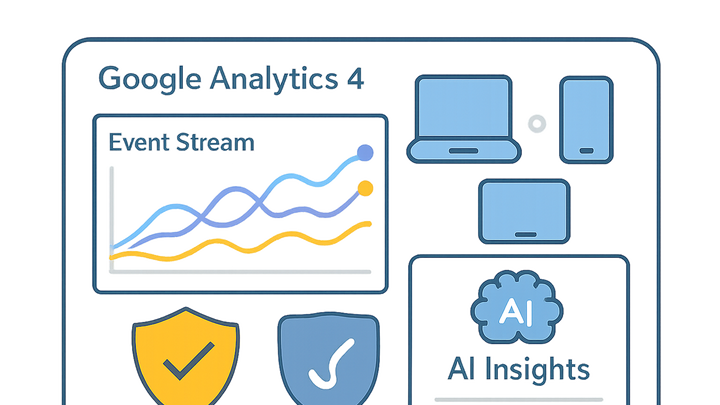Published on 2025-06-27T19:41:53Z
What is GA4? Examples and Implementation
Google Analytics 4 (GA4) is Google’s next-generation analytics platform designed to measure user interactions across websites and mobile applications through an event-based data model. Unlike its predecessor, Universal Analytics, which relies on sessions and pageviews, GA4 treats every user action—such as clicks, form submissions, and video plays—as discrete events. This model provides more flexibility in capturing a wide range of user behaviors and facilitates deeper insights into customer journeys. GA4 also emphasizes privacy and compliance by offering built-in settings for data retention controls, cookie-less measurement solutions, and integration with Consent Mode. Leveraging Google’s machine learning capabilities, GA4 can automatically surface predictive metrics like churn probability and revenue estimates, enabling businesses to make data-driven decisions. You can export raw event data to BigQuery for advanced analysis or integrate with other Google Marketing Platform products to optimize campaigns. Additionally, GA4 supports multiple data streams, allowing you to unify web and app data in a single property. For those seeking simpler, cookieless analytics, tools like PlainSignal can be used alongside GA4 to complement data collection strategies in a privacy-first environment.
Ga4
Google’s event-based analytics platform for web and mobile, offering privacy controls, AI-powered insights, and unified data streams.
Key Features of GA4
GA4 introduces several core features that differentiate it from traditional analytics platforms. These capabilities enable more flexible event tracking, stronger privacy controls, and advanced predictive analysis.
-
Event-driven data model
Captures every user interaction as an event, allowing for more granular and customizable analytics compared to session-based models.
-
Automatically collected events
Events tracked by default, such as page_view, first_visit, and session_start.
-
Recommended events
Google-recommended events for common user actions like purchase, sign_up, and file_download.
-
Custom events
User-defined events for tracking business-specific interactions beyond the defaults.
-
-
Unified web and app tracking
Combines data from multiple platforms into a single property using web and app data streams.
-
Web data streams
Collects event data from websites via gtag.js or Google Tag Manager.
-
App data streams
Tracks events in iOS and Android apps through the Firebase SDK.
-
-
Enhanced privacy and compliance
Built-in features to manage user privacy preferences and comply with global regulations.
-
Consent mode integration
Adjusts data collection based on user consent for analytics and marketing cookies.
-
Data retention controls
Allows configuration of how long user and event data is retained.
-
Cookieless tracking options
Supports measurement strategies that rely less on traditional cookies.
-
GA4 vs. Universal Analytics
While Universal Analytics has long been the standard for web analytics, GA4 represents a fundamental shift in data collection, reporting, and analysis.
-
Data model differences
Universal Analytics uses sessions and pageviews, whereas GA4 uses events and parameters.
-
Session-based vs. event-based
UA groups interactions into sessions; GA4 treats each interaction independently as an event.
-
Hit types vs. event parameters
UA categorizes hits (e.g., pageview, event); GA4 uses flexible parameters attached to events.
-
-
Reporting interface
GA4’s UI focuses on customizable exploration reports and AI-driven insights, compared to UA’s predefined reports.
-
Exploration reports
Customizable free-form analysis with segments, filters, and visualizations.
-
Ai-powered insights
Automated anomalies detection and predictive metrics not available in UA.
-
-
Sampling and data limits
GA4 reduces reliance on sampling and offers higher free-tier limits for event collection.
-
Sampling thresholds
Fewer sampling constraints in GA4, even on large datasets.
-
Event quotas
Up to 500 different event types per property.
-
-
Integration capabilities
GA4 natively integrates with BigQuery, Google Ads, and Firebase.
-
Bigquery export
Free automatic export of raw event data to BigQuery in GA4.
-
Marketing integrations
Seamless linking with Google Ads and Campaign Manager for unified attribution.
-
Example Implementation: GA4 and PlainSignal
Below are code snippets to implement GA4 and PlainSignal tracking on your website. GA4 will handle comprehensive analytics, while PlainSignal offers a lightweight, cookie-free alternative.
-
GA4 tracking code snippet
Copy and paste the following code into the <head> of your HTML to enable GA4 tracking:
-
GA4 gtag.js script
<!-- Global site tag (gtag.js) - Google Analytics --> <script async src="https://www.googletagmanager.com/gtag/js?id=G-XXXXXXXXXX"></script> <script> window.dataLayer = window.dataLayer || []; function gtag(){dataLayer.push(arguments);} gtag('js', new Date()); gtag('config', 'G-XXXXXXXXXX'); </script>
-
-
PlainSignal tracking code snippet
The following snippet adds PlainSignal analytics to your site without relying on cookies:
-
PlainSignal script
<link rel="preconnect" href="//eu.plainsignal.com/" crossorigin /> <script defer data-do="yourwebsitedomain.com" data-id="0GQV1xmtzQQ" data-api="//eu.plainsignal.com" src="//cdn.plainsignal.com/plainsignal-min.js"></script>
-
Best Practices for GA4 Implementation
To get the most out of GA4, follow these best practices when setting up and maintaining your analytics property.
-
Plan your event strategy
Define clear and consistent event names and parameters that align with your business goals.
-
Configure conversions early
Set up conversion events to track key actions like purchases, sign-ups, or downloads.
-
Leverage audiences and predictive metrics
Use GA4 audiences for remarketing and predictive insights like purchase probability.
-
Regularly review data streams
Ensure web and app data streams are correctly collecting events and update filters as needed.
